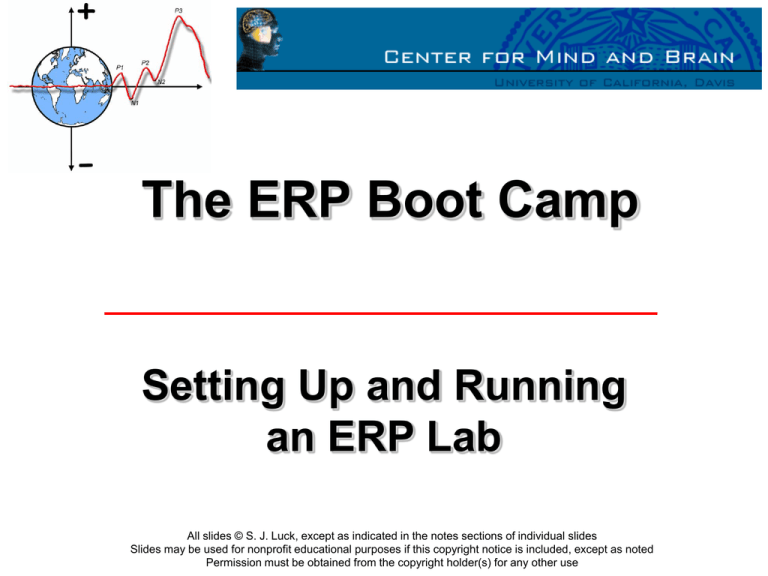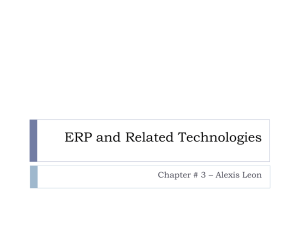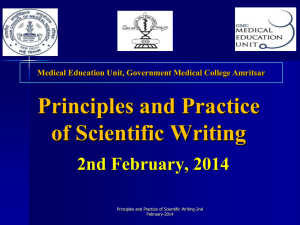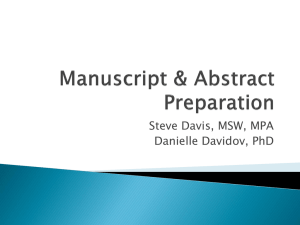ERP Boot Camp Lecture #10
advertisement

The ERP Boot Camp Setting Up and Running an ERP Lab All slides © S. J. Luck, except as indicated in the notes sections of individual slides Slides may be used for nonprofit educational purposes if this copyright notice is included, except as noted Permission must be obtained from the copyright holder(s) for any other use Recording Chamber • Do you really need one? • Probably not if: - You’re looking at slow components and can low-pass filter with a 50% cutoff at 30 Hz - And you’re not near any major source of electrical noise • Elevators, centrifuges, power transformers, ventilation fans - You don’t care about gamma oscillations • They’re good for keeping subjects focused • They tend to get warm, so it may actually be better not to • have one if skin potentials are a major source of noise You can build one from 2x4’s and copper screen Courtesy of Lynne Reder Seating • Key points: - Comfortable to avoid muscle noise - Don’t want subjects to fall asleep - Don’t want electrodes to rest on anything • Recliners were once common - Not good if you have electrodes over the back of the head • I recommend high-quality office chair - Glides rather than wheels - Mark the floor • I haven’t had much luck with chin rests Response Devices • Need to be held in a comfortable position - Don’t want subject holding arms up - Standard computer keyboards are bad • Game controllers work well - Mass-produced -> reliable • Constant and variable timing errors are possible - RT is so variable that a bit of timing variability will usually have virtually no impact (unless you are looking at response-locked averages) - EMG for best response timing - Can measure timing errors by putting a mic next to device and recording “click” along with event code Hints for Running Subjects • ~60 minutes of “run time” per session - More for interesting experiments - Whole session is about 3 hours • Runs of 4-6 minutes with 2-3 20-second breaks - Less makes it inefficient to deal with electrodes, etc. - More leads to fatigue - Some labs do all-day sessions with lot of breaks • Dilution Rule: Don’t dilute good data with bad data - Adding noisy trials doesn’t improve the S/N ratio • Watch the EEG throughout the session - Look for artifacts, bad connections, etc. • Watch the subject with a video camera Hints for Running Subjects • Happiness Rule: A happy subject is a good subject - Compliance with task - Compliance with artifact control instructions - Less noise • Talking to subjects - Treat subject like a person, not like a piece of meat - Chat while putting on electrodes (or video) • Tell them exactly what will happen -- this reduces stress - Chat during breaks - Note: Some subjects don’t want to talk -- that’s OK • Keeping subjects happy - Food and drink (is caffeine a confound?) - Eye drops (single-use) - Music Looking at the Data • Do a fairly complete analysis of the first subject’s data before running anyone else - • All the main comparisons among ERP waveforms Accuracy (and RT if recorded) for each main condition There may be a serious problem with event codes, etc. “Nothing focuses the mind quite as much as real data” Take a look at the individual subjects and the grand averages every 3-4 subjects - Grand averages will give you more power to see something funky in the data - But don’t get too freaked out if the results look a little funny or aren’t conforming to your predications - Be especially concerned about “impossible” results (e.g., effects that consistently begin before time zero) - Look at calibration data for each subject if you can Ethical Issues • Everything that applies to behavioral experiments plus… - Risk of disease transmission • • High impedance helps Need thoughtful disinfection (even for high impedance) - Risk of electrical shock • - • Optical isolation and/or battery power Headache from electrode cap Gel in hair Long duration of experiment Claustrophobia Concerns about privacy of EEG data Providing clear information in advance is the best way to prevent problems Stimulus Presentation • Testing the timing of event codes - Digitize at ~1000 Hz (higher for auditory) - Present stimuli along with event codes - For auditory stimuli, connect auditory output (or a microphone) to the digitization system • You might want to use a square-wave tone or a 50-Hz sine wave - For visual stimuli, point some kind of light pen to the video monitor and connect to digitization system - See when the stimuli are actually presented relative to the event codes • Auditory artifacts - Speaker in headphones may induce a current - Post-auricular muscle twitch CRT Basics When you draw something, nothing happens until the frame buffer is updated AND the raster beam reaches the right part of the monitor LCDs operate similarly, but often there is an additional delay of several milliseconds before the stimuli actually appear Stimulus Timing Jitter • • • • What does a constant delay between event code and stimulus do to the averaged ERP? - Time shift - Can be fixed with a filter What does a variable delay between event code and stimulus do to the averaged ERP? - Distribution of delays is convolved with jitter-free “real” waveform - Modest low-pass filter For most cognitive paradigms, effects are minimal - But not always You need to understand exactly what the jitter is doing, and this usually requires measuring it Stimulus Timing Jitter 1 Distribution of Stimulus Delays 0.8 Example: Stimulus appears 0, 10, or 20 ms after event code with even distribution 0.6 0.4 0.2 Waveform appears at 0, 10, or 20 ms with equal likelihood 0 0 ms 10 ms 20 ms 1 Averaging these together is equal to replacing each point in the distribution of delays with a scaled and shifted version of the ERP waveform 0.8 0.6 0.4 0.2 0 -100 0 -0.2 -0.4 -0.6 100 200 300 400 500 600 700 0-ms delay 10-ms delay 20-ms delay Avg Across Delays The result is slightly low-pass filtered and shifted to the right in time What is frequency response of filter produced by jitter? Writing an ERP Paper • Rule #1: Write with a specific audience in mind - But keep in mind that the reviewers are the first and most important audience • Rule #2: Intro must end with a set of competing hypotheses about a general issue and then a set of corresponding predictions - May want to explicitly address reason for using ERPs • Rule #3: Results should be organized to lead reader to a conclusion (logical flow of ideas) - Descriptive statistics first, then inferential statistics • Rule #4: Discussion should recap major results and conclusions that can be drawn - Often followed by possible objections that can be discarded (and perhaps some that cannot) Example Decision Letter Dear Dr. XXXXX: I gave your manuscript a quick reading so that I could choose appropriate reviewers. After this quick reading, it was clear to me that the manuscript cannot be accepted in its present form. Thus, to save everyone time and effort, I am rejecting this version of the manuscript, but I will allow you to submit a revised manuscript if you are certain you can overcome the problems with the current version. Example Decision Letter Dear Dr. XXXXX: In most ERP papers that make a significant contribution to broad questio ns in cognitive neuroscience, the Introduction ends with a set of specific predictions about the pattern of ERP results that will be obtained. That is, competing hypotheses about broad issues in cognitive neuroscience are raised in the first part of the Introduction, and then specific predictions about the ERP results are given that will distinguish between the competing hypotheses. This is both an indicator of the likely importance of the study and an important aid to readers, who can much better underst and the methods and results if they know what general patterns of results can be expected and how these results are related to the broad issues addressed by the study. The present manuscript does not contain such predictions. If you submit a revision, you should rewrite the Introduction in this manner. I gave your manuscript a quick reading so that I could choose appropriate reviewers. After this quick reading, it was clear to me that the manuscript cannot be accepted in present form. Thus, torecap save It is its also useful for the Discussion section to begin with a brief of the everyone time and major findings and the conclusions that can be drawn from them. Again, helps make it clear that the represents a s ignificant advance inbut I will allow you to effort, I am rejectingthis this version ofstudy the manuscript, knowledge about the broad issues that were initially raised in the Introduction. It is also helpful for the casual reader who does not want to submit a revised manuscript if you are certain you can overcome the read the details of your methods and results, but instead wishes to quickly see your “bottom line.” It was quite difficult for me to determine what problems with the current version. conclusions could be drawn from this manuscript . If you submit a revision, you should rewrite the beginning portion of the Discussion in this manner. [Some details about this particular study] In most ERP papers that contribution to broad questio ns ACTION: Imake cannot accepta thesignificant manuscript for publication in its current form. However, I invite you to submit a revision if you feel that you can fully address the concerns in this letter. Please note, however, that a a set of specific in cognitive neuroscience, the raised Introduction ends with substantial amount of time and effort is required to review a manuscript, so should not submit you are certain that thewill revised be obtained. predictions about theyou pattern ofa revision ERPunless results that That is, manuscript draws solid and important conclusions about the cognitive and/or neural processes involved in [topic of study]. That is, the paper should be of competing hypotheses about broad issues in cognitive neuroscience are interest to [topic of study] researchers who are not interested in ERPs per se. If you believe that your revised manuscript makes this sort of strong raised in the first part the Introduction, specific predictions and of important contribution, I will be very happy toand send thethen revision out for review. about the ERP results are given that will distinguish between the competing hypotheses. This is both an indicator of the likely importance of the study and an important aid to readers, who can much better underst and the Method Section Should Include… • Number of trials per condition (explicitly) • Recording sites, electrode type, amplifier gain, filters, sampling rate and resolution, impedance, reference, and offline re-referencing • • - Include impulse response function details for offline filters Artifact rejection procedures - Include observed mean and range of % rejected trials - Include # of subjects rejected and standard for rejection - Rejection of trials with behavioral errors ERP measurement procedures - Measurement windows and perhaps justification • Greenhouse-Geisser epsilon adjustment • See Picton et al. (2000)








